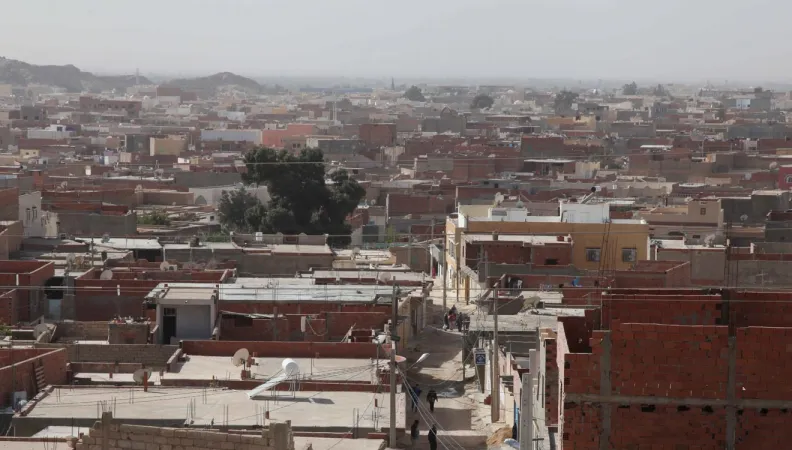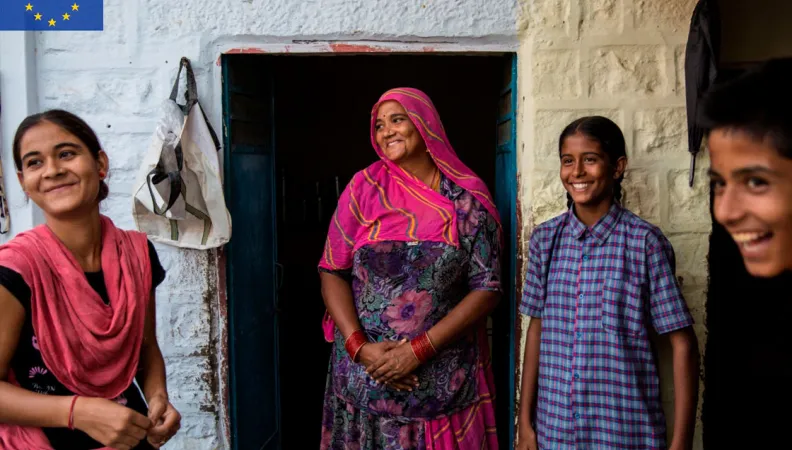Addis-Abeba, Éthiopie
Addis Ababa
Éthiopie
 As part of the ECOPRONAT research programme, AFD is collaborating with the World Resources Institute (WRI) to develop a strategic framework for identifying and deploying nature-based solutions (NBS) in urban areas, taking Addis Ababa (Ethiopia) and Kigali (Rwanda) as case studies. Natural ecosystems and biodiversity are indeed essential to ensure the livability of cities, especially in the face of climate change and its impacts. Their integration into urban planning processes is also essential.
As part of the ECOPRONAT research programme, AFD is collaborating with the World Resources Institute (WRI) to develop a strategic framework for identifying and deploying nature-based solutions (NBS) in urban areas, taking Addis Ababa (Ethiopia) and Kigali (Rwanda) as case studies. Natural ecosystems and biodiversity are indeed essential to ensure the livability of cities, especially in the face of climate change and its impacts. Their integration into urban planning processes is also essential.
Context
According to a 2021 OECD report, two-thirds of African cities are at “extreme” risk of climate and water-related shocks. Violent climate events, heat waves and droughts are thus at the top of the risks incurred by urban areas. Rapid urbanization, unsustainable development and degradation of natural ecosystems exacerbate these risks.
Nature-based solutions (NBS), which rely on natural ecosystems and the services they provide to human activities, address these urban challenges, while simultaneously providing benefits in terms of human well-being and biodiversity. However, they are still little integrated into urban planning processes and decision support tools available to planners. The lack of knowledge, data and experimentation on nature-based solutions therefore hampers their adoption and deployment.
This project is part of the ECOPRONAT research programme, which supports research on how to better take into account biodiversity and mainstream it into key economic sectors.
Objectives
The objective of this research project is to enable, through the construction of a strategic framework, the deployment and scaling of nature-based solutions, in particular to address water and heat risks. The challenge is to improve the ecological resilience of cities by helping them identify the risks they must prepare for, to assess the potential of NBS to address them and to develop implementation and funding strategies for these NBS as part of the urban planning process.
A fast, effective and practical methodology for assessing the potential of nature-based solutions will be made available to the cities of Addis Ababa and Kigali, which are the two pilot cities of this research project. The project is led by WRI, in partnership with the Addis Ababa Urban Development Department, the Ethiopian Institute of Architecture and the Rwanda Young Water Professionals Association. This methodology is intended to be adopted by other urban centers to allow a broader appropriation and mobilization of NBS in cities.
Method
At the methodological level, the construction of a strategic framework for nature-based solutions is interesting for two reasons:
- Identification of flood risks, heat islands, water supply and biodiversity potential of cities through the production of composite maps and the mobilization of satellite data;
- Participatory construction of the strategic framework through workshops with stakeholders of both cities to validate the priority areas of intervention and identify the NBS most adapted to the issues of each area.
Results
Developed by the WRI research team with the cities of Addis Ababa and Kigali, the Strategic NbS Framework can support cities in selecting and implementing appropriate nature-based solutions (NbS).
By integrating globally available data sets with local data, it helps identify areas of a given city that are susceptible to extreme flooding and heat, as well as opportunities to expand urban green spaces and create ecological corridors.
To ensure successful implementation, collaboration between public authorities, technical experts, and community leaders is essential. Using this framework, citywide maps can be quickly generated to identify priority areas. After a validation by city stakeholders, field experts then play a key role in designing effective NbS, tailored to local conditions.
Although it has limitations in data detail, the Framework provides a solid starting point to build sustainable cities. Additional guidelines provide technical information on usable NbS, as well as case studies. These guidelines are available for download below:
A webinar from the Research Conversations series was held to present the project's findings, and these research findings are summarized in a policy brief available for download below.
Research findings
The research project identified a series of lessons to facilitate the deployment of nature-based solutions (NbS), taking into account the specific needs of cities. These lessons highlight the potential of nature in urban resilience planning and climate action:
- To increase awareness and institutional integration:
- Set up multi-stakeholder processes to support dialogue and the prioritization of identified NbS.
- Rely on case studies to facilitate understanding and engagement.
- To enhance data availability for more effective planning:
- Combine local and global datasets to carry out multi-hazard assessments (flooding, urban heat islands, etc.).
- Encourage citizen science initiatives for data collection, and ensure it is considered in decision-making.
- To strengthen planning and implementation linkages:
- Establish dedicated governance structures (such as a mayoral committee) to coordinate various technical services involved and mobilize funding.
- Develop common reference frameworks (design standards, guidelines, etc.) to strengthen political and public support.
- To secure long-term financing:
- Integrate NbS into existing city investment programs.
- Include strategies for public-private partnerships and use a multi-benefit assessment framework to demonstrate their long-term value.
- To adapt solutions to the local context and ensure monitoring:
- Launch NbS pilot projects with monitoring systems to track their performance.
- Integrate gender, equity, and inclusion considerations from the selection phase of each NbS.
Learn more
Other projects on Nature-based Solutions supported by ECOPRONAT


 Legal notice EU (project) It is critical to assess how, and the extent to which, projects and programmes supported by development agencies contribute to the goal of reducing within country inequalities. A methodology (Morabito et al. 2021) proposes a set of analytical tools identifying potential distributional impacts of development programmes or projects by focusing on whether programmes’ beneficiaries belong to the bottom 40% of the wealth distribution through a mix of analytical tools.
Legal notice EU (project) It is critical to assess how, and the extent to which, projects and programmes supported by development agencies contribute to the goal of reducing within country inequalities. A methodology (Morabito et al. 2021) proposes a set of analytical tools identifying potential distributional impacts of development programmes or projects by focusing on whether programmes’ beneficiaries belong to the bottom 40% of the wealth distribution through a mix of analytical tools.
Context
Addressing persistent inequalities in income and other dimensions of wellbeing is a key policy objective of the Sustainable Development Goal 10. Multilateral and bilateral donor agencies have been directing their efforts towards promoting good governance, human and economic development, fighting hunger and reducing inequality.
The increase in development funding towards inequality reduction is accompanied by a need to monitor progress on the SDG 10 but most importantly, by the need to evaluate the contribution of development towards achieving this goal. However, measuring the distributional impacts of development cooperation projects is a challenging task due to a myriad of factors, including the effects that domestic redistributive policies, the structure of labour markets and other factors, such as institutions, have on inequality. The methodology developed by Morabito et al. enables the analysis of the potential contributions of development projects on inequality by looking primarily at the extent to which they disproportionally benefit the most vulnerable through a mix of analytical tools (a scoreboard, a statistical analysis of development projects based on the Equity Tool, a fiscal incidence analysis).
This methodology has first been tested on three development projects funded by AFD in Cameroon, Colombia and Tunisia as part of the first phase of the Research Facility on Inequalities.
This project was part of the first phase of the Research Facility on Inequalities, coordinated by AFD and funded by the European Commission's Directorate-General for International Partnerships over the 2017-2020 period. The first phase of the Facility has led to the conduct of 22 research projects and the publication of around 100 research papers and policy briefs.
A second phase of the research project was launched in 2022 with the aim to extend the initial phase, to further test the validity of the methodology with respect to income and other forms of inequalities and to develop the guidelines for an inequality marker.
Goal
The initial phase of the project aimed at piloting the application of the methodology developed by the researchers on three projects funded by the AFD:
- A programme supporting urban housing improvements in Tunisia;
- A programme focusing on capacity-building of Small- and Medium-Sized Enterprises in Cameroon;
- A budget support operation aimed at supporting a health sector reform in Colombia.
The objective was to test the methodology and evaluate the relevance of its results, and, based on these findings, to review and adjust the methodology itself.
The second phase of the project aimed:
- To develop the guidelines for an inequality marker for development cooperation ;
- To further test the methodology on four AFD and EU development programmes:
- A programme promoting sustainable access to electricity for the unserved poor rural populations in Benin;
- A programme improving the health and living conditions of the inhabitants of the rural district of Isingiro (Uganda) and its refugee camps;
- A programme facilitating trade between Ethiopia and Djibouti and enabling businesses and producers, as well as the most vulnerable populations, to benefit from these improvements;
- A programme contributing to the adaptation of the communities to climate change in Vietnam.
Method
The initial study identified whether programmes’ beneficiaries of the three selected interventions belonged to the bottom 40% of the wealth distribution, through a mix of analytical tools:
- First, a scoreboard that assessed whether or not inequality reduction was a central objective of development programmes;
- Second, the Equity Tool, which helped assess the position of direct beneficiaries within the national (urban or rural) wealth distribution;
- Third, the Commitment for Equity Tool, which helped estimate the distributional impact of general or sectoral budget support.
The methodological steps of the second phase of the research project were the following:
- Refining and upgrading the inequality markers and the scoreboard to provide clear benchmarks and indicators, aligned with evaluation approaches used by the European Commission, to assess whether development interventions focus on the poorest bottom 40% individuals, households or vulnerable groups that are targeted by specific development policies;
- Extending the scope of the Equity Tool questionnaire to include questions that capture the distribution of projects beneficiaries among vulnerable groups (women, ethnic, religious minorities, etc.);
- Applying the revised methodology to the four case studies.
Results
Results of the first phase of the project:
Overall, the results underscore the importance of considering a pro-poor targeting ex-ante when designing development cooperation interventions that explicitly (or implicitly) aim to contribute to the reduction of inequalities in partner countries. The main strength of the methodology is that it allows an assessment of the potential reach of interventions for the bottom 40 percent of the income distribution. Therefore, the information provided thanks to this methodology can be critical to fine-tune policies before they are implemented and maximize their redistributive impact.
You may find the research paper here: The distributional impacts of development cooperation projects
Results of the second phase of the project:
The second phase of this project resulted in :
- The elaboration of guidelines for the implementation of the methodology, which were used to develop the European Commission's Inequality Marker. The I-Marker assesses whether, and to what extent, inequality reduction is an objective of development intervention. For this purpose, a set of criteria has been developed to establish if: - I-0: Inequality reduction is not targeted; - I-1: Inequality reduction is a significant objective; - I-2: Inequality reduction is the principal objective. The I-Marker focuses on the bottom (poorest) 40% or socio-economically disadvantaged individuals, households or groups. Watch the video on the Inequality Marker for more information ;
- A report on the testing of the methodology on the four case studies (available soon).
Lessons learned
This project highlighted the importance of identifying direct and indirect beneficiaries of the projects, but also, more broadly, of having a complete understanding of the development cooperation interventions, which are being analyzed, especially their objectives and conditionalities.
Equally important is the involvement of key stakeholders to communicate the objectives, scope and limitations of the studies. In some cases, the inclusion of a qualitative component in the form of interviews, consultations, or eventually field missions, may be required to ensure the successful implementation and completion of studies.
Contact:
 Legal notice EU (project) The project aims to establish the causal impact of three large-scale social-protection schemes in India, Ethiopia and Peru on both the level of economic resources and a number of dimensions of inequalities. The researchers involved in this project use a novel longitudinal dataset to carry out comparative analysis of these phenomena and draw conclusions that are relevant for other countries with similar circumstances.
Legal notice EU (project) The project aims to establish the causal impact of three large-scale social-protection schemes in India, Ethiopia and Peru on both the level of economic resources and a number of dimensions of inequalities. The researchers involved in this project use a novel longitudinal dataset to carry out comparative analysis of these phenomena and draw conclusions that are relevant for other countries with similar circumstances.
Contexte
Social-protection schemes have become a popular form of intervention in developing countries both by governments and within the international-development community, as they are seen as a tool to combat the adverse impacts of natural and economic crises. However, the empirical evidence on the effectiveness of these programs remains mixed. Notwithstanding the wealth of interest from policy makers, donors, and researchers, there is a paucity of evidence about the distributional incidence of these programs. Existing work has often not been able to establish longer-run effects of public-works programs on poverty and inequality. In addition, there is a lack of focus on horizontal and spatial inequalities. This research project intends to fill this evidence gap.
This project is part of the first phase of the Research Facility on Inequalities, coordinated by AFD and funded by the European Commission's Directorate-General for International Partnerships over the 2017-2020 period. The first phase of the Facility has led to the conduct of 22 research projects and the publication of around 100 research papers and policy briefs.
Objectif
This research project proposes to investigate the distributional impact of three large-scale social-protection schemes - the Productive Safety Net Program (PSNP) in Ethiopia, the Mahatma Gandhi National Rural Employment Guarantee Scheme (NREGS) in India, and the Juntos conditional cash-transfer program in Peru. These programs were chosen because they are large-scale projects involving a coordinated effort by governments, donors, local authorities and individual households. The programs cover three countries with diverse social, cultural, political, and economic contexts from which to draw lessons for future policy initiatives.
The researchers propose to go beyond measuring the direct intended impacts of the programs and rather focus on their indirect, and not necessarily intended, consequences. In particular, they first consider the effect of these programs on the income and wealth of program participant households over both the shorter- and longer-run. They then turn to the programs’ impact on horizontal and spatial inequalities, as well as their effect on household social relations and the distribution of resources within households.
Méthode
Unlike traditional benefit-incidence studies, the researchers exploit policy differences across time and space, both within and across the countries, to provide causal estimates of the social-policy impacts. They use the Young Lives cohort study that collected data both pre-and post-program implementation between 2002 and 2014 in all three countries. They exploit a number of aspects of the Young Lives cohort study and the roll-out of the social-protection schemes in each country to produce estimates that deal with non-random program placement.
The researchers planned to begin by conducting an individual-specific pre- and post-program comparison of income and wealth. Then to exploit the staggered rollout of the social-protection programs across districts to causally identify the impact of the schemes on a set of indicators. They intend to compare changes in districts that received the program earlier to changes in districts that received the program later in a difference-in-differences approach. Last but not least, they will further assess the impact of the program on individual outcomes, taking advantage of administrative boundaries to separate treated and control areas in a geographic regression discontinuity.
Results
You may find the research papers here :
- Social protection and inequality: Evidence from Ethiopia, India and Peru
- Social protection and multidimensional poverty: Lessons from Ethiopia, India and Peru
- Social protection and intrahousehold resource allocation: Evidence from three large-scale programs
You may find the policy briefs here:
- Policy Dialogues No. 1 | Social Protection: The Impact on Inequality in Ethiopia, India, and Peru
- Policy Dialogues No. 2 | Social Protection: The Impact on Multidimensional Poverty in Ethiopia, India, and Peru
- Policy Dialogues No. 3 | Social protection: impact on household resource allocation and child undernutrition
Contact:
Conchita d’Ambrosio, Professor of Economics, Université du Luxembourg
Cecilia Poggi, Research Officer, AFD

